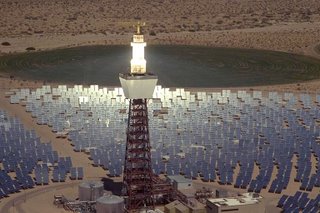Summer heat is on and that makes me think!
You may have probably heard of Solar Air Conditioner. It can produce cooling effect by absorbing heat from Sunlight. Normally, these types of ACs are absorption type refrigeration systems using Ammonia cycle, salt and vapor pressure
stuff.
But these are still limited to research labs and some commercial applications.
In this post I'm going to talk about using Electricity (Solar) to get some extra points of efficiency from your existing AC.The inspiration for this idea came from ice factories, industrial cooling towers, our fridge and the thermodynamics chapter in my physics textbook.
Lets start with the basics i.e. physics (basics|physics, it rhymes!)
2nd Law of thermodynamics tells us that energy flows in one direction only, whenever there is a
net increase in the disorderliness (entropy) of a thing, it flows from a less disordered state to more. For example, you put a drop of ink in a beaker full of water, ink spreads i.e. becomes
more disordered. You can't expect the dissolved ink to converge and become a drop again. Similar things happen with our drawers and cupboards! Actually, it is the 2nd law of thermodynamics that gives direction to
Time. Think about this!
Coming Back to our AC;
An AC or Fridge seems to break this law! Isn't it?
How it can pick out
heat from a cold area and throw it in the
hot one?
As cold air is more ordered, you can see, AC tries to decrease disorderliness on the in-side and increase it on the out-side. But the 2nd law says for
anything to happen in this universe there should be a
net increase in disorderliness.
So we can say that if an AC is working, then it throws more heat out-side than it absorbs from in-side. Now from where that 'extra' heat is coming? Of course from the electricity that it consumes.
Now you see
why an AC works.
Click here if you want to know
how it works!
Efficiency?

A refrigerator continuously cycles a series of thermodynamic processes to transfer heat from low temp to high temp. As you saw earlier this cycle is not 100% efficient, it has to throw out more heat than it can capture. For an ideal refrigerator (as shown) the thermodynamic cycle is called Carnot cycle and it is called Carnot refrigerator.
Its efficiency is not expressed in percent but in Coefficient of Performance (COP) given by;

Kc is the COP.
Clearly, efficiency of a fridge or AC depends on the temperature difference between inside and outside. More its COP better it is!
If T
H and T
L are both close to each other then the denominator is close to zero and COP jumps. See the graph:

It is clear from the graph that for lower outside temperatures, AC performs best. We generally set the thermostat around 24 to 26 degrees. In this temperature range you can see how dramatic is the effect of lower outside temperatures.
That's why an AC will perform best in Europe and worst in South Asia.
At our place, in India, temperature lies around 40 degrees, so the black curve in the above graph shows how it'll perform.
Whew! Now the Climax!At the back of an AC you'll find a large copper coil with aluminum fins (called condenser), that coil is the "
TH" region as shown in the diagram above. If we could
somehow reduce the temperature of this coil, AC's performance will increase. There is a large fan along the coil for cooling and the aluminum fins act as heat sink, just like the cooling mechanism on your computer processor.
My idea is to use a small water pump and a container to continuously sprinkle water on the condenser coil thereby reducing its temperature considerably. Water is a good conductor of heat and it has really good capacity to hold heat. That's the reason why car engines are cooled by water.
Amazing thing about this concept is that the cooling fan will blow air on the wet fins, evaporating water, thereby cooling the coils
even below the temp. of water itself!
Win-Win Situation
Using this concept of water cooling,
we save energy, as efficiency of the AC increases its energy consumption will decrease.
Secondly, using this concept, we are
producing more energy, how?
We saw earlier that water evaporates when sprinkled on condenser coil. Water vapor thus formed rise upwards to form clouds, producing rain, this rain water then travels down the rivers eventually ending up behind a Dam, producing power. Simple isn't it?
20 to 50 Watt pump will be sufficient. You can even use a small solar panel to do the job. More sunlight gives more pumping power!
So, get going and do something! Of course Don't forget to tell me!
Click on 'comments' to give feedback on this post.























